Text for this page contributed by Matt VanAcker, Co-chair of "Save the Flags"
Edited by William Eichler
VIDEO SEGMENT ON MICHIGAN'S FLAGS
FLAGS PRESENTED
Before leaving for the field of battle Michigan regiments were presented with beautiful silken flags. Typically a regiment would receive a stand of colors—one flag, the national red white and blue and the other a regimental--usually with a field of blue emblazoned with the Federal coat of arms (an eagle with outstretched wings) or with the Michigan coat of arms. The flags quite often were presented to the regiments by the ladies of dignitaries of their communities in grand ceremonies. The flags had mottoes like:
- "In Jure Vincimus-We Conquer in Right" - 4th Michigan Cavalry
- "Do Your Duty"-6th Michigan Infantry/Heavy Artillery
- " From the Ladies of Adrian to the Fourth Michigan-DEFEND IT" - 4th Michigan Infantry
- "At her country's sacred call her patriot sons will peril all" - 2nd Michigan Infantry
- "We come to war not on opinions but to suppress treason" - 14th Michigan Infantry
- "Fear not Death fear Dishonor" - 6th Michigan Cavalry
- “Presented to the Tenth Regiment Infantry by the Citizens of Flint” - 10th Michigan Infantry
FLAGS IN BATTLE
These flags stood for everything the men were fighting for. The colors stood for country, for community, for family and for the union. Civil War regiments, consisting initially of approximately 1,000 men, were organized in specific areas of the state. The men who joined these regiments quite often knew each other very well. They joined with men and boys they had grown up with, had gone to school with, attended church services with, and many were related to each other. It was not uncommon to have fathers or even grandfathers serving alongside sons, grandsons, uncles and nephews; the 24th Michigan had 135 pairs of brothers serving in the same regiment. The flags they bore into battle, presented to them by their communities and sometimes handmade by the ladies of those communities, were a tangible link to Michigan. They were a reminder of from whom they came and the cause they were fighting and dying for.
Frederick Curtenius, Colonel of the Sixth Michigan Infantry Regiment at the flag presentation ceremony for his regiment held in Baltimore, Maryland stated:
"To a soldier, a good soldier, the colors of his regiment are a priceless treasure. For their honor he will submit willingly to any sacrifice, and a stain cast upon them is a stigma upon his own character. In the hour of peril he will rally round them heedless of the din of battle and he considers his life of no value in their defense”.
The flags were also used as a very practical tool on the field of battle. Flags stood as markers for the men of the regiment - they knew and could instantly recognize their banners. Through the dust, smoke and confusion of battle the men could spot their flags to follow them whether in the advance or retreat. When the color bearer planted the staff in the ground the men knew their duty was to stand their ground—to rally round the flag.
Confederate and Union soldiers alike recognized the importance of these flags and the importance of capturing them or of killing the color bearer. Needless to say, the honor of being a flag bearer was basically a death sentence and yet there was no shortage of men who were willing to do the job. It was considered the highest honor to serve in the color guard or to actually serve as the color bearer. The very first Medals of Honor were awarded during the Civil War, most often for the capture of a Confederate battle flag, or for incredible acts of courage in the defense of the flags. Sixty-Nine men from Michigan would be awarded the medal, many well after the war and some posthumously.
Perhaps one of the best quotes regarding the importance the men placed upon their colors comes from a man who served with the Thirteenth Michigan Infantry. First Lieutenant Willard Eaton of Otsego, MI was promoted rapidly, becoming a Captain in 1862 and a Major the following year. After the battle of Chickamauga in the fall of 1863 where three color bearers of the Thirteenth fell and half of the regiment were killed, wounded or were missing Eaton wrote a letter home to his niece:
“You speak of guarding the flag, now I am aware that thousands of people have but little thought about a flag, or that it is of any importance, let such take the field and go forth to battle under a flag and bear it through the storm of death until half their number have fallen under its folds and then they will be prepared to appreciate it.”
Not long after writing this, Eaton was promoted to colonel and was killed in action March 19, 1865 at Bentonville, North Carolina – one month before the end of the war and five days before his promotion to colonel arrived.
Due to damage in battle, flags often were worn beyond the ability to use them in the field. They were sometimes returned early to the state and another flag was presented to replace it. In time, many regiments came to serve under many flags – each their own and none less dear to the men than the other.
The feelings of the men for their flag were well expressed by Lt. Henry Beach, upon sending home a standard of the First Michigan Cavalry regiment in 1864:
“Gentlemen, I have the honor to forward to you the tattered standard of our regiment. Where, when and how well we have defended it, we will let the history of the war tell. It has waved over many a bloody field, and been pierced by canister and rifle shot. Yet we trust we have never forsaken or dishonored it. Sirs, we venerate, we almost worship it, and confiding it to your care we humbly pray you will preserve it as long as the Peninsular State has a name and a place in the nation; and whenever God sparing our lives to return, any of us shall behold, we will bow to its familiar device, while we weep for our brave comrades who have fallen beneath it.”
FLAG RETURN
At the conclusion of the war these battle scarred and bullet-torn flags were returned to a grateful state by the regiments, the men who carried them and fought under them, in a grand ceremony at Detroit on July 4, 1866. In accepting the flags, Michigan’s Governor Henry Crapo, pledged that:
“They will not be forgotten and their histories left unwritten. Let us tenderly deposit them, as sacred relics, in the archives of our state, there to stand forever, her proudest possession.”
The flags were mementos of friends lost and a country saved. Not all of the flags were returned to the state at the conclusion of the war; some of the regiments elected to hold onto their battle flags. They would reappear throughout the years at regimental reunions, some eventually making their way into the state collection and some whose whereabouts are still unknown. A few are publicly displayed in museums or government buildings.
FLAGS IN THE CAPITOL
With the construction of the current State Capitol in Lansing in 1879 the flags were deposited there. First in a military museum in the first floor south wing and then later in 1909 in shallow metal and glass cases in the Capitol rotunda. Many men who came to the opening of the Capitol on January 1st, 1879 came specifically to see their battle flags again, they pressed their faces to the glass cases and the sight of their banners brought tears to the eyes of many of the old veterans.
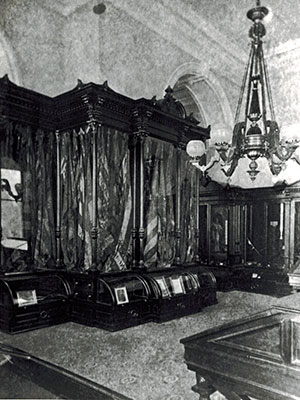 The flags, which were now joined by flags carried by Michigan troops in the Spanish American War and World War I, remained in the cases until the 1960’s when some were sent out for conservation in commemoration of the centennial of the Civil War. This was a very different type of conservation than is standard practice today. The flags were sewn between layers of dyed net to encapsulate them. The stitching was done with a running zig-zag stitch through the layers of net--piercing the flag with thousands of individual needle holes.
The flags, which were now joined by flags carried by Michigan troops in the Spanish American War and World War I, remained in the cases until the 1960’s when some were sent out for conservation in commemoration of the centennial of the Civil War. This was a very different type of conservation than is standard practice today. The flags were sewn between layers of dyed net to encapsulate them. The stitching was done with a running zig-zag stitch through the layers of net--piercing the flag with thousands of individual needle holes.
The flags were returned to their rotunda cases and remained there until the restoration of the Capitol (1989-1992). At that time an alarming discovery was made; the flags were deteriorating and had literally started to fall apart. What were their elements of destruction? Time, the effects of improper lighting, fluctuating temperature and humidity and gravity all played a part. The flags, most of which measure 6x 6 1/2 ft., were hung from their original staffs and were falling apart due to the strain of their own weight. What years of battle damage could not do to the flags was actually being accomplished by these hidden enemies.
Upon a recommendation of one the country's leading textile conservators and with the full agreement of the Capitol Battle Flags task force, a volunteer group made up of historians, re-enactors and museum and Capitol personnel, the flags were removed from the Capitol and placed in a specially designed archival storage unit in the state historical museum in Lansing. There, the flags are being preserved, researched and indeed are being saved. This effort is not however without cost; it is very expensive to conserve these flags and the state of Michigan has not and does not fund this project. As part of “Save The Flags,” a project to preserve the state’s collection of historic battle flags, groups, individuals or families may adopt a flag by contributing to its preservation. By donating these needed funds our citizens are ensuring that the flags and the history of the men who so courageously fought and died under them will be preserved.
We are saving flags. We are fulfilling Governor Crapo’s pledge that these flags not be forgotten and their histories left unwritten. The veterans of the Union army and Grand Army of the Republic would be pleased by our actions.
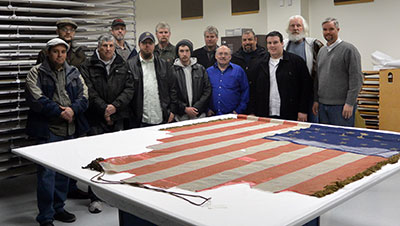 Today, the state’s flag collection can be viewed by private appointment. In addition, one flag is always on display in the Michigan Historical Museum. Some of the flags are available to be seen on-line. We provide links below to those flags, as well as images and locations of the flags we know of that aren’t part of the main state collection.
Today, the state’s flag collection can be viewed by private appointment. In addition, one flag is always on display in the Michigan Historical Museum. Some of the flags are available to be seen on-line. We provide links below to those flags, as well as images and locations of the flags we know of that aren’t part of the main state collection.
The best way to schedule a private tour to see more of the flags than the one on display at the Historical Museum, please contact:
Attn: Matt VanAcker or Kerry Chartkoff
Save the Flags
Michigan State Capitol
P.O. Box 30014
Lansing, Michigan 48909-7514
517/373-5157 or 517 373-5527
mvanacker@legislature.mi.gov
kchartkoff@legislature.mi.gov
Michigan's Battle Flags
Currently, there is no complete way to view all of the battle flags on the internet easily. A very basic and limited portion of the collection were put up in a combined effort between the Michigan Historical Museum and Save the Flags. Separately, the Seeking Michigan site allows you to search for them via the State Archives. Where possible, we will provide links to those pages, as copyright prevents us from showing you the images of the flags here. We will also note for you the entirety of the state's collection (as far as Civil War era flags go) so you know what you can visit should you schedule your own visit. Battles were hard on the colors. Often a regiment had to return several sets of colors to get new ones that would withstand future battles. Here you will see all the flags in the collection. In addition, several flags are not in the state collection. Where possible, we will provide images of these flags and their stories too.
1st Michigan Infantry
The First Michigan Infantry had quite a number of flags returned to the state. There are ten in the state collection. Five are national colors, three are regimental colors and the remaining two are flank markers. A full list of them, along with the Save the Flags collection identifiers, are listed below.
- SC-4-90 - intact national
- SC-5-90 - intact national
- SC-6-90 - fragmentary national with battle honors
- SC-7-90 - two intact swallow tail flank markers
- SC-17-90 - intact swallow tail flank marker
- SC-18-90 - intact national
- SC-19-90 - fragmentary regimental partial state coat of arms
- SC-20-90 - intact national
- SC-219-90 - regimental
- SC-228-90 - intact regimental state coat of arms
2nd Michigan Infantry
Our luck is a lot better with the 2nd Michigan Infantry. With all four flags in the Save the Flags collection being intact, the website shows all four. We are happy to provide links to them all.
- SC-1-90 - intact national with battle honors
- SC-8-90 - intact national with battle honors
- SC-16-90 - intact national
- 93.57.1 - Hardy flag wool bunting national
Go to the 2nd Michigan Infantry Page
3rd Michigan Infantry
There are three flags in the state collection. One can even have two sides viewed of it.
- SC-9-90 - partially intact regimental
- SC-9-90 partially intact regimental - back side
- SC-14-90 - fragmentary regimental
- SC-15-90 - fragmentary national
4th Michigan Infantry
The 4th Michigan has a very intersting flag in the collection. Most of the flags assigned to each regiment were for the entire regiment. In the case of the 4th, there is one flag that was presented to one company. The Dexter Guards were a militia company which made up one of the 4th's initial companies. Their flag is preseved with the collection and is distinct since it was for them, not the regiment as a whole.
5th Michigan Infantry
There are five flags belonging to the 5th Michigan Infantry in the state collection.
- SC-22-90 - fragmentary regimental
- SC-23-90 - intact national
- SC-27-90 - national swallow tail flank marker
- SC-39-90 - fragmentary national
- SC-40-90 - intact national - This is believed to be the last of the national colors given to the 5th.
6th Michigan Infantry
The 6th entered service as an infantry regiment. During their service, they were converted to a heavy artillery regiment. The surviving flags show this change.
- SC-37-90 - intact national battle honors
- SC-38-90 - intact national battle honors
- SC-24-90 - intact regimental crossed cannons Heavy Artillery
7th Michigan Infantry
There is but one flag in the collection from the 7th Michigan Infantry. When the instructions were received by the Governor Crapo to return the flags to the State after the war, the 7th did so with most of their flags. Yet, they kept on flag, a regimental color, and it joined them for years at reunions. When the reunions came to an end, it was donated to the City of Monroe and has come to reside in the Monroe County Historical Museum, where you can see it today.
7th Michigan Flag at Monroe Musuem
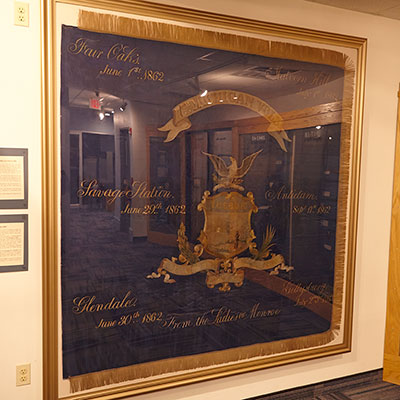
8th Michigan Infantry
There are five flags of the 8th Michigan Infantry in the collection.
- SC-21-90 - intact national - This was the first flag presented to the regiment. It was returned in March 1863.
- SC-26-90 - fragmentary national battle honors
- SC-34-90 - intact regimental
- SC-35-90 - intact national battle honors - Given by the Citizens of Detroit as a replacement in March 1863, this flag has battle honors painted on it.
- SC-36-90 - fragmentary national
9th Michigan Infantry
There are three in the collection. None are part of the Michigan Historical Musuem website but all show up in the Seeking Michigan search of the State Archives.
10th Michigan Infantry
There are two flags in the collection. The first one listed is believed to be the flag presented to the regiment in February 1864 by Colonel Lum. It is in very good shape and probably didn't survive much combat in that condition.
11th Michigan Infantry
Here are the five flags in the collection. We provide links to four of the five.
- SC-30-90 - intact national
- SC-41-90 - intact national
- SC-58-90 - intact regimental
- SC-59-90 - intact national battle honors
- SC-217-90 - intact regimental
12th Michigan Infantry
There are four flags in the collection. The first listed was sewn by the wife of a member of the regiment.
- SC-42-90 - intact regimental
- SC-43-90 - intact regimental
- SC-56-90 - national with battle honors
- SC-57-90 - national with battle honors
13th Michigan Infantry
There are four flags here. It is very much worth noting that the 13th was marching with the top flag at the battle of Chickamauga. After that battle, then Major Willard Eaton wrote of the flag in the quote we used in the article above. It was this flag and it's national compaion that he wrote of when he wrote those words home.
- SC-44-90 - regimental
- SC-45-90 - fragmentary national with battle honors
- SC-55-90 - fragmentary national
- SC-135-90 - fragmentary regimental
14th Michigan Infantry
There are five flags of the 14th in the collection. They have a great story as they served both as infantry and, at one point, mounted infantry. Since the last flag displayed has the word "Veteran" on it, this flag is believed to be a later flag.
- SC-46-90 - fragmentary regimental
- SC-47-90 - fragmentary national
- SC-48-90 - intact national
- SC-53-90 - fragmentary regimental
- SC-54-90 - intact regimental - with battle honors on it
15th Michigan Infantry
The collection holds four flags that flew over the 15th during it's time in service.
- SC-49-90 - intact regimental
- SC-50-90 - fragmentary regimental
- SC-51-90 - national with battle honors
- SC-52-90 - intact national
16th Michigan Infantry
17th Michigan Infantry
If you have interest in the 17th, be sure to make an appointment and visit the flags. You'll see both the large national and regimental standards that were carried in the center of the regiment, plus two of the flank markers. These were carried on either end of the regiment and helped keep the line straight.
18th Michigan Infantry
The flag second flag on this list is believed to have been made by the Tiffany Company in New York.
19th Michigan Infantry
There are only parts of two flags remaining in the collection - both of them national colors.
20th Michigan Infantry
There are four flags in the collection carried by the 20th. Of the four, we know of links for three of them.
- SC-66-90 - fragmentary regimental
- SC-71-90 - national with battle honors
- SC-72-90 - national with battle honors
- SC-215-90 - fragmentary regimental
21st Michigan Infantry
There are four flags of the 21st Michigan Infantry in the State collection. However, this is not all. One of the flags was given to the regiment by the ladies of Ionia. When the instructions were received by the Governor Crapo to return the flags to the State after the war, the 21st did so with most of their flags. However, they felt that the flag that was given to them by the ladies of Ionia should be returned to them. They did just that on July 4, 1865. Below, you will see photos of the flag which still resides in the Ionia Courthouse. There is one other flag able to be seen of the other four.
- SC-67-90 - fragmentary national
- SC-68-90 - intact regimental
- SC-69-90 - national with battle honors
- SC-70-90 - intact national
21st Infantry Flag in Ionia
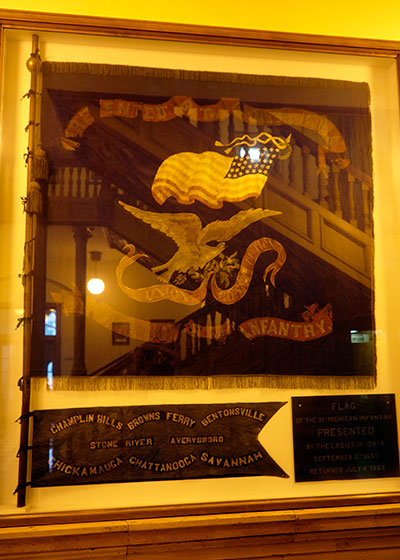
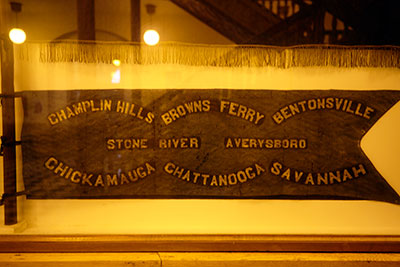
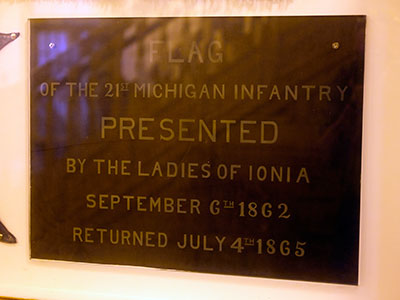
22nd Michigan Infantry
The first flag listed is the national presented to the regiment when it was raised and first commanded by former state governor, Moses Wisner. Wisner's home is still a museum in Pontiac and can be visited as well.
23rd Infantry:
24th Infantry:
- SC-82-90 - intact swallow tail flank marker
- SC-83-90 - fragmentary national
- SC-84-90 - fragmentary national - This is the flag that the 24th carried into battle at Gettysburg.
- SC-93-90 - intact swallowtail flank marker
- SC-94-90 - fragmentary regimental
- SC-95-90 - intact national
25th Infantry:
Battle was not kind to the flags. Take a look at the fragmentary national below. However, notice the square cut near where the blue field would be. This flag may have been cut up as the regiment disbanded and some of the men of the regiment presented with souvenirs.
26th Infantry:
- SC-86-90 - fragmentary national
- SC-87-90 - intact national with battle honors
- SC-88-90 - intact swallowtail flank marker
- SC-90-90 - intact swallowtail flank marker
- SC-91-90 - regimental
Below is an epsiode of "Civil War Digital Digest" which tells the story about one of the fragments of the 26th Michigan Flag in the state collection.
27th Infantry:
- SC-100-90 - national with battle honors
- SC-101-90 - national with battle honors
- SC-115-90 - regimental with battle honors
- SC-116-90 - fragmentary regimental
- SC-117-90 - fragmentary regimental
28th Infantry:
29th Infantry:
30th Infantry:
The 30th was raised not to leave the state of Michigan. Instead, the plan for the regiment was to split the companies across the state's forts to help guard Michigan from the "disaffected in Canada." They served a one year term at the end of the war.
1st Cavalry:
There are two flags from the 1st Michigan Cavlary in the state colleciton. One is non-regulation.
1st Michigan Cavalry Flag in Dearborn
The Dearborn Historical Musuem houses one of the national colors of the 1st Michigan Cavalry. The story of it's journey is very interesting. Below, we share the story as it's shared by the museum:
The flag, opposite this exhibit, was presented to the 1st Michigan Cavalry in September of 1861 in Hamtramck, Michigan. This flag would bear historic witness to the greatest struggle in American history....the American Civil War.
The flags color bearer was Sergeant Thomas Henry Sheppard. The position of Color Bearer was a great honor, reserved for men who had shown courage and extreme patriotism to their country. Being the Color Bearer was a dangerous position; usually being unarmed in battle with nothing but the Regimental Flag in ones hands. The flag itself was often the rallying point of the regiment in fierce battle and the "moral" rallying point of the Army. Many instances are sighted in the history of the Civil War where units were near defeat when the color bearer would wave the flag vigorously and yell: "Rally round the flag boys." In which cases the regiment would regroup around the color bearer and stand their ground or re-form for an attack. The soldiers guarded their flag with their lives.
This flag has seen its share of action. These stars and stripes were fired upon at Harpers Ferry, Winchester, Middleton, Strasburg and Harrisonburg. Sergeant Sheppard also carried this flag into battle at Orange Court House, Cedar Mountain and the 2nd Bull Run. In spite of a grazing bullet wound to his temple, Sergeant Sheppard held onto his Company's flag, now riddled with over 70 bullet holes.
From July first through July third, 1863, two massive armies of North America met in battle at the small Pennsylvania town of Gettysburg, As the Federal Army of the Potomac met the Confederate Army of Northern Virginia, fierce fighting broke out....the Battle of Gettysburg had begun. At Gettysburg, with the "Michigan Brigade" headed by George Armstrong Custer, Company "E" of the 1st Michigan Cavalry took on Steward's Confederate Cavalry. In the charges of the Federals rode Sergeant Sheppard and this 34 star flag of Company "E" of the 1st Michigan Cavalry.
During one of the charges, Sergeant Sheppard was wounded by a Confederate saber. The wounds were not fatal but the Sergeant was unable to remount. Knowing that he would be captured, Sergeant Sheppard tore this flag from its staff and folded it into his Cavalry jacket. Sheppard thought that although he would be captured, his flag would not become a war trophy in Richmond.
Taken prisoner, with his flag safely hidden inside his coat, Sheppard was first taken to Libby Prison and then to the prison at Belle Isle. As bad as these two prisons were, the worst was yet to come. In February of 1864, Sergeant Sheppard and his comrades were taken by train to a small railroad station near Andersonville, Georgia, and were escorted inside the wooden stockade of the notorious Andersonville Prison. The living conditions of Andersonville were not good. Thousands died of starvation, exposure and disease. Yet, Sergeant Sheppard survived with his tattered, bullet ridden flag. Keeping the flag from "capture," Sheppard later said, was his reason for surviving his captivity.
On November 20, 1864, Sergeant Sheppard with other prisoners were exchanged. On December 10th he arrived in Annapolis, Maryland. The Sergeant and his beloved flag were finally safe in the arms of their country once again.
If you want to see this flag in person, go to the Dearborn Historical Musuem and check it out. It's in the basement.

3rd Cavalry:
4th Cavalry:
5th Cavalry:
- SC-133-90 - national swallowtail
- 93.88.1 - regimental standard
- 93.88.2 - national swallowtail
- 2000.80.1 - (“Mounted Rifles”) Company I red over white swallowtail
6th Cavalry:
- SC-121-90 - swallowtail regimental standard
- SC-121-90 - the back of the same flag
- SC-132-90 - swallowtail (missing) regimental
7th Cavalry:
- SC-122-90 - swallowtail national
- SC-123-90 - swallowtail red over white
- SC-131-90 - regimental standard
8th Cavalry:
9th Cavalry:
10th Cavalry:
11th Cavalry:
1st Light Artillery:
- B Battery SC-126-90 - swallowtail national
- Unknown Battery SC-127-90 - swallowtail national
- E Battery SC-157-90 - swallowtail national
- F Battery SC-156-90 - swallowtail national
- H Battery SC-140-90 - swallowtail national
- H Battery SC-141-90 - swallowtail red over white
- J Battery SC-155-90 - national swallowtail
- K Battery SC-154-90 - national swallowtail
- 14th Batt SC-139-90 - national swallowtail
1st Engineers and Mechanics:
1st Michigan Sharpshooters:
1st Colored Infantry:
Corps and Designating Flags:
Michigan Cavalry Brigade Guidon at Monroe Historical Museum
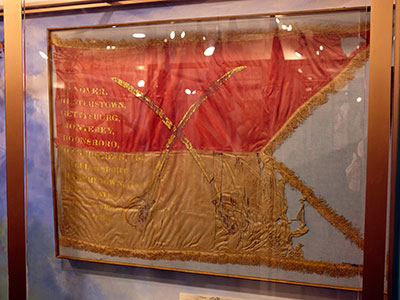
The Monroe Historical Museum houses the brigade marker of the Michigan Cavalry Brigade. This marked General Custer's headquarters for the months is was in use. There is an informational sign near it which reads:
Civil War silk guidon flag with crossed sabers and a list of engagements beginning with Hanover, 30 June 1863 and ending with Culpepper, 13 September 1863. The guidon was in use for the Michigan Cavalry Brigade as the 2nd Brigade of the 3rd Cavalry Division of the Army of the Potomac.
Loaned by: The Brice C. W. Custer Collection
Find out more about visiting the Monroe Historical Musuem by visiting our Museums page.
9th Army Corps, 3rd Brigade
1st Division, 20th Army, Army of the Cumberland
1st Division, 9th Army Corps
3rd Division, 1st Brigade, 5th Army Corps
5th Division Center, 14th Army Corps, Dept. of the Cumberland
- SC-221-90 - 5 star blue bunting listed as # SC-99-90 on the website
6th Division, 2nd Brigade, Cavalry Corps